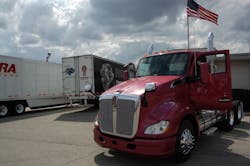GE Fleet, of course, is a big proponent of leasing trucks vs. buying them – a strategy some think more Class 8 fleets will switch to over the next five to six years.
Yet the firm’s recent survey of 200 CFOs and managers with fleets of at least 300 vehicles found that those still following the traditional ownership path remain reluctant to change because, in Jastrow’s words, “that’s the way they’ve always done it.”
Indeed, GE Fleet found that two-thirds of the respondents to its survey – some 66% – said “tradition or culture” were the reasons they still purchased and owned vehicles the old fashioned way.
That’s despite more than half (51%) of the companies owning their fleets surveyed by GE Fleet noting that “capital expenditure limitations” remains one of their biggest financing challenge, compared to 11% of companies in the poll that lease their vehicles.
“Change management is a big concern for fleet owners; far more so than it is for companies that lease their fleets,” Jastrow said. “One challenge faced by businesses that own their fleets is management of total cost of ownership. That’s because the decision to outsource certain operational activities is a complex one, as it’s often seen as a trade-off between maintaining control over fleet operations and managing activities in the most cost efficient manner.”
Yet that’s not altogether strange where trucking is concerned. In fact, I’d argue that are plenty of good reasons why fleets remain reluctant to engage in such change, with the tortuous exhaust emission reduction journey completed by the industry five years ago the prime example.
[And not everyone thinks the journey was worth it, as this study by the Massachusetts Institute of Technology explains.]Those emission control mandates made new equipment awfully pricey, with global consulting firm Frost & Sullivan estimating that the average cost of a new tractor-trailer ranges between $140,000 and $175,000 these days.
That breaks down as follows: a new Class 8 tractor costs anywhere from $110,000 to $125,000 while a new trailer can range from $30,000 to $50,000, the firm said.
And, frankly, the industry is still facing an upward climb where operating costs are concerned in terms of dealing with the fiscal fallout generated by regulatory initiatives and the need to pay drivers more money, just for starters.
For many years, fleets extended the equipment ownership cycle in order to avoid those steep cost curves – a tactic that ultimately resulted in the “creakification” if you will of the commercial truck population.
Last November, IHS Automotive determined that the average age for Class 4 through Class 8 reached 14.7 years in 2014, up from 12.5 years in in 2007. What’s more, the subset of Class 6 vehicles now averages 20.9 years – the highest among the commercial truck grades – while the average age of Class 5 stabilized around 11.9 years.
And it’s the costs and headaches associated with keeping older trucks up and running that may convince many fleets to start looking more closely at leasing options , GE Fleet’s Jastrow explained – and not just to reduce equipment acquisition expenses either.“Companies that lease their fleets tend to be more active in utilizing programs that assist with managing total cost of ownership and safety,” he said. “While limited ‘capex’ is a big challenge for fleets that own versus those that lease, either model can benefit from added services that bolster compliance, maintenance, and the overall safety of their drivers.”
He stressed to me that there’s a lot of potential “value-add” to be had from such ancillary services that, at the end of the day, could significantly help lower TCO metrics for fleets operating older equipment.
“You really must look at the whole package,” he stressed. “In most of the situations I’ve seen with fleets operating older equipment, the trucks are just so aged you’ll never get enough capex to replace it all. Then there’s the extra maintenance, shop overtime, and added vehicle downtime required to keep it operating.”
Then there are the fuel economy gains to consider as well, Jastrow emphasized. “Over the last four to five years we’ve really seen fuel economy increase significantly for medium- and heavy-duty trucks,” he noted. “Just getting a 2% to 3% boost in fuel economy can have a huge impact on a fleet’s bottom line.”
And it’s such cost savings that might very well convince more traditionally-minded trucking fleets to explore changing their ways.






